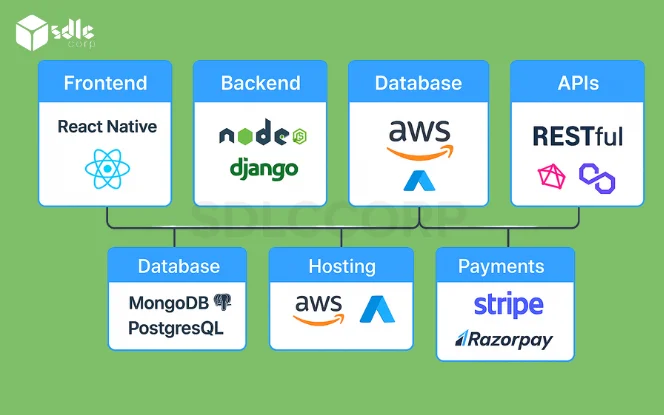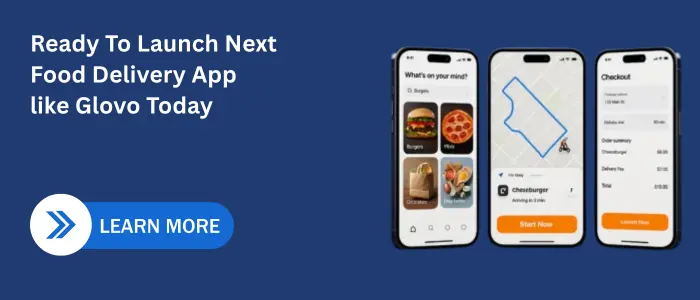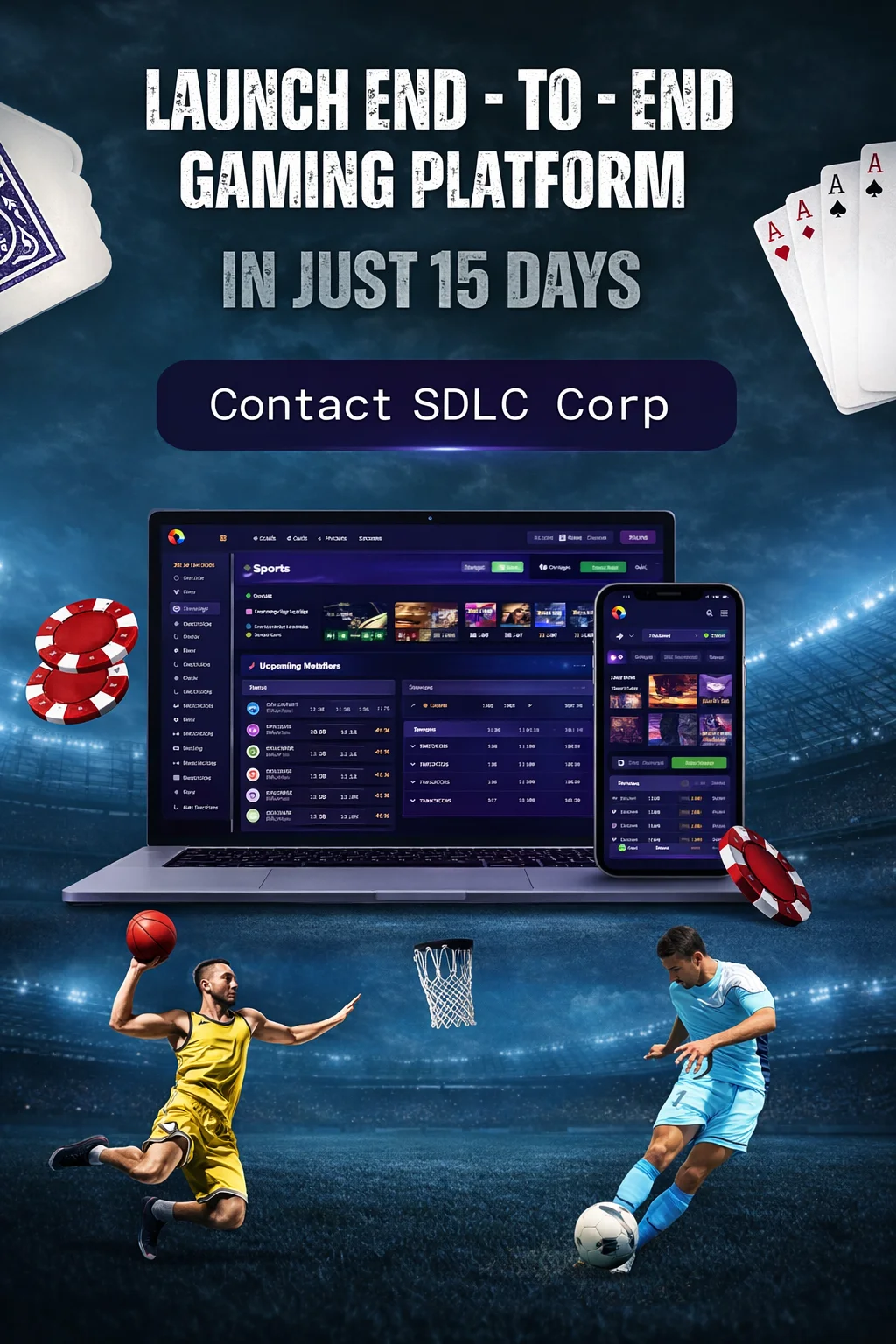Introduction
Why Build a Food Delivery App Like Glovo?

- Diverse Delivery Capabilities
Deliver food, groceries, flowers, medicine, and packages through a single multi-category delivery app maximizing revenue and reach. - High Market Demand
The global food delivery app development market is projected to reach $320+ billion by 2029, making it one of the fastest-growing digital sectors. - Low Investment With MVP
Start with a basic food delivery app MVP and scale gradually as user demand increases, reducing early-stage development risk. - Strong Monetization Opportunities
Commission fees, delivery charges, subscription plans, and in-app promotions make it a profitable on-demand delivery business model.
Key Features of a Glovo-Like App
User Panel Features
Live Order Tracking
2. Multiple Delivery Options
3. Quick Registration & Login

4. Push Notification Technology
5. Ratings & Reviews

Users rate restaurants and riders to help improve service transparency and quality.
Builds trust in app and vendors.
Informs new users before ordering.
Allows vendor performance evaluation.
6. Bookmark Option
Save favorite items and restaurants for faster repeat orders and a personalized experience.
- Simplifies future checkouts.
Improves user loyalty and re-engagement.
Reduces app abandonment rate.
7. Multiple Payment Options

Supports UPI, wallet, card, and cash payments for flexibility and convenience.
Broadens accessibility across payment types.
Enables safe and encrypted transactions.
Speeds up order completion.
8. Discounts & Promotions
Offer limited-time deals, coupons, and referral bonuses to attract and retain customers.
Incentivizes more frequent purchases.
Helps acquire new users through referrals.
Promotes brand loyalty and retention.
9. In-App Help Center

Users get instant support via AI chatbots or FAQ sections inside the app.
- Handles routine queries instantly.
- Reduces support center burden.
- Improves overall customer satisfaction.
Restaurant Panel
1. Vendor Registration & Login

Secure vendor registration with business verification for onboarding new restaurants to your food delivery platform.
Ensures legitimacy through document-based approval.
Streamlines onboarding for new restaurant partners.
Protects platform from fraudulent sign-ups.
2. Menu Flexibility & Customization
Vendors can update food items, prices, availability, and delivery times instantly via the partner dashboard.
Real-time updates on menu visibility.
Allows availability toggles during rush hours.
Improves customer satisfaction through menu accuracy.
3. Dynamic Order Tracking
Monitor each order’s journey from kitchen to doorstep in real time via restaurant dashboard.
Helps manage kitchen prep time efficiently.
Avoids delays by coordinating with delivery agents.
Gives vendors visibility into delivery performance.
4. Effective Communication with Riders & Customers
In-app chat or call enables real-time coordination with riders and resolution of customer issues.
- Reduces errors in order handling.
- Improves coordination with delivery agents.
- Enhances trust between vendor and customer.
Rider Panel Features
1. Delivery Time Optimization

AI-powered routing shows riders the shortest path and real-time ETA to boost delivery speed.
Reduces late deliveries with optimized navigation.
Displays accurate delivery times for better planning.
Minimizes idle time between tasks.
2. Efficient Order Control
Riders can accept or reject tasks, toggle availability, and view their delivery history.
Increases rider flexibility and autonomy.
Streamlines task transitions and reduces confusion.
Helps monitor past deliveries and performance.
3. Smooth Communication

Built-in messaging system connects riders with customers and restaurants for better coordination.
Prevents miscommunication and delays.
Enables real-time updates on delivery status.
Supports coordination during complex orders.
4. Insights at a Glance
A dedicated dashboard shows earnings, delivery stats, customer ratings, and order volume.
- Tracks daily, weekly, and monthly performance.
- Displays total earnings and bonuses.
- Highlights areas for improvement based on feedback.
Technology Stack

- Frontend – Flutter, React Native
Enables fast and responsive cross-platform mobile app development for both Android and iOS users. - Backend – Node.js, Express.js
Ensures scalable, event-driven architecture to handle high user traffic and real-time operations. - Database – PostgreSQL, MongoDB
Manages structured and unstructured data efficiently with support for fast querying and performance. - Real-time Updates – Socket.io, Firebase
Facilitates live order status, driver tracking, and instant notifications without page reloads. - Maps & Geolocation – Google Maps API, Mapbox
Supports delivery routing, address detection, and real-time location services for users and riders. - Payment Gateway – Stripe, Razorpay, PayPal
Enables secure, multi-currency, and flexible payment processing for global transactions. - Push Notifications – Firebase Cloud Messaging, OneSignal
Sends timely order updates, promotional messages, and alerts to users and delivery agents.
Choosing the right tech stack is crucial for performance, scalability, and efficiency. Explore the latest tools driving innovation in our blog on Must-Have Mobile App Development Tools.
Cost Breakdown to Build an App Like Glovo
| Tier | Basic MVP | Mid-Level App | Full-Scale Super App |
|---|---|---|---|
| Cost | $20K – $30K | $40K – $50K | $60K – $100K |
| Timeline | 4–7 Weeks | 8–10 Weeks | 12–18 Weeks |
| Features |
|
|
|
| Security | JWT, HTTPS | 2FA | AI fraud detection |
| Integrations | Payment + OTP | Maps + Wallet | ERP + AI APIs |
Factors That Affect Food Delivery App Cost

- App Complexity & Features
The more advanced your food delivery app is, the higher the development cost. Features like real-time order tracking, in-app chat, and flexible delivery options significantly increase complexity and time. - Choice of Platform
Building for Android, iOS, or both impacts your cost. Cross-platform development using Flutter or React Native can reduce budget. - UI/UX Design
Custom and intuitive design increases user engagement but also adds to the overall design cost depending on animations and micro-interactions. - Third-party Integrations
Integrating maps (Google Maps), payment gateways (Stripe, Razorpay), CRMs, or analytics tools will require extra development time and budget. - Backend Infrastructure
A scalable backend with real-time databases, microservices, and API gateways ensures performance, especially during order spikes but it adds cost.
Monetization Models for a Glovo-Like Food Delivery App

- Commission from Orders
Charge restaurants a fixed or percentage-based fee on every successful transaction made through your app. - Delivery Fees
Collect dynamic or flat delivery charges from users based on distance, order size, or location zone. - Surge Pricing
Increase delivery charges during peak hours, weekends, or high-demand conditions to boost platform revenue. - Subscription-Based Delivery Plans
Offer users unlimited free deliveries and exclusive discounts through monthly or yearly subscription packages. - In-App Advertising
Display banner or pop-up ads from third-party partners or local brands to earn additional ad revenue. - Featured Listings for Restaurants
Allow restaurants to pay for priority placement or premium exposure in search and category pages.
Step-by-Step Process to Develop a Food Delivery App

- Requirement Analysis & Market Research
Define your goals, target audience, app type (single vendor or multi-vendor), and analyze competitors like Glovo. - Feature Planning & Technology Selection
List essential features for users, vendors, and riders. Finalize your tech stack (Flutter, Node.js, Firebase, etc.). - UI/UX Design
Design user journeys and intuitive interfaces for each panel—customer, restaurant, and delivery agent. - Mobile & Backend Development
Build the frontend app (iOS/Android) and backend services to manage orders, deliveries, payments, and notifications. - API & Third-party Integrations
Integrate payment gateways, map APIs, SMS/OTP verification, push notifications, and chatbot systems. - Testing & Quality Assurance
Run functional, security, and usability testing on real devices to ensure a stable and error-free app. - Deployment & Post-Launch Support
Publish on app stores, configure servers, monitor performance, and provide regular updates and technical support.
For a deeper breakdown of timelines across different development stages planning, design, development, and testing check out our detailed guide on How Long It Takes to Develop an App.
Conclusion
Developing a high-performing, user-centric food delivery app like Glovo demands a strategic blend of market insight, technical expertise, and scalable architecture. Choosing the right Mobile App Development Company plays a critical role in ensuring seamless execution from design and development to integration and post-launch support. At SDLC CORP, we specialize in crafting custom food delivery solutions tailored to your business goals and audience needs. If you’re ready to turn your idea into a profitable on-demand platform, Contact Us to schedule a consultation with our experts.
Must Read: Related Blogs from SDLC CORP





